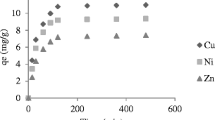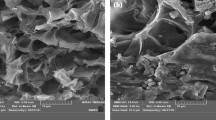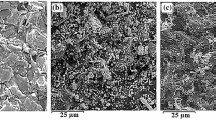Abstract
In this research, Pb (II), Co (II), and Ni (II) toxic heavy metal ions adsorption from synthetic aqueous system have been studied using the activated carbon prepared from Citrus limetta leaves. Therefore, the relationship between the adsorption parameters (solution pH, dosage of adsorbent, temperature, initial concentration of the ions, and adsorption time) and the removal percentage of the prepared adsorbent have been investigated. Additionally, the adsorbent was analyzed through BET, SEM, EDX, FTIR, and XRD analyses. According to the results, the maximal adsorption efficiencies for heavy metal ions were achieved in pH = 6, the adsorbent dosage of 1 g/L, temperature = 25 °C, the ion initial concentration of 5 mg/L, and contact time of 60 min, which were 99.53%, 98.63%, and 97.54% for Pb, Co, and Ni ions, respectively. Based on Kinetic studies, the performance of pseudo-second-order kinetic model was better than pseudo-first-order model for the description of time-dependent behavior of the process. Additionally, the equilibrium data were fitted by Langmuir and Freundlich isotherms, while the former performed better than the latter. The maximum adsorption capacity values for Pb, Co, and Ni ions were achieved equal to 69.82, 60.60, 58.139 mg/g, respectively. Considering the thermodynamic data, the studied processes were exothermic and spontaneous.














Similar content being viewed by others
Abbreviations
- C i :
-
Initial concentration of metal ions (mg/L)
- C e :
-
Equilibrium concentration of metal ions (mg/L)
- K 1 :
-
Pseudo-first-order model rate constant (1/min)
- K 2 :
-
Pseudo-second-order kinetic rate constant (g.mg−1.g−1)
- K e :
-
Adsorption equilibrium constant
- Kf :
-
Freundlich model constant (L/mg)
- K L :
-
Adsorption energy (L/mg)
- n :
-
Freundlich model constant
- q e :
-
Equilibrium capacity (mg/g)
- q max :
-
Maximum adsorption capacity (mg/g)
- q t :
-
The value of the adsorbed ion per gram of adsorbent at time t (mg/g)
- R :
-
Universal gas constant (J/mol⋅k)
- %R :
-
Adsorption efficiency
- R L :
-
Adsorption intensity
- T :
-
Absolute temperature (K)
- t :
-
Time (minutes)
- V :
-
Volume of solution (L)
- W :
-
Adsorbent mass (g)
- ΔG°:
-
Gibbs free energy (kJ/mol)
- ΔH°:
-
Enthalpy (kJ/mol)
- ΔS°:
-
Entropy (J/mol.K)
References
Bakhtiari N, Azizian S (2015) Adsorption of copper ion from aqueous solution by nanoporousMOF-5: a kinetic and equilibrium study. J Mol Liq 206:114–118
Dashamiri S, Ghaedi M, Asfaram A, Zare F, Wang S (2017) Multi-response optimization of ultrasound assisted competitive adsorption of dyes onto Cu(OH)2-nanoparticle loaded activated carbon: central composite design. Ultrason Sonochem 34:343–353
Zhao F, Repo E, Yin D, Meng Y, Jafari S, Sillanpaa M (2015) EDTA-cross-linked beta-Cyclodextrin: an environmentally friendly bifunctional adsorbent for simultaneous adsorption of metals and cationic dyes. Environ Sci Technol 49:10570–10580
Nomanbhay SM, Palanisamy K (2005) Removal of heavy metal from industrial wastewater using chitosan coated oil palm shell charcoal. Electron J Biotechn 8:43–53
Kobya M, Demirbas E, Senturk E, Ince M (2005) Adsorption of heavy metal ions from aqueous solutions by activated carbon prepared from apricot stone. Bioresour Technol 96:1518–1521
Sheng PX, Ting YP, Chen JP, Hong L (2004) Sorption of lead, copper, cadmium, zinc, and nickel by marine algal biomass: characterization of biosorptive capacity and investigation of mechanisms. J Colloid Interf Sci 275:131–141
Meitei MD, Prasad MNV (2013) Lead (II) and cadmium (II) biosorption on Spirodela polyrhiza (L.) Schleiden biomass. J Environ Chem Eng 1:200–207
King P, Srinivas P, Kumar YP, Prasad VS (2006) Sorption of copper (II) ion from aqueous solution by Tectona grandis lf (teak leaves powder). J Hazard Mater 136:560566
Sekar M, Sakthi V, Rengaraj S (2004) Kinetics and equilibrium adsorption study of lead (II) onto activated carbon prepared from coconut shell. J Colloid Interf Sci 279:307–313
Fu F, Wang Q (2011) Removal of heavy metal ions from wastewaters: a review. J Environ Manag 92:407–418
Zhao X, Song L, He J, Wu T, Qin Y (2010) Adsorption characteristics of Ni2+ ion onto the diethylenetriaminepentaacetic acid-melamine/polyvinylidene fluoride blended resin. Int J Energy Environ 1:121–132
Kurniawan TA, Chan GY, Lo WH, Babel S (2006) Physico–chemical treatment techniques for wastewater laden with heavy metals. Chem Eng J 118:83–98
Wang YH, Lin SH, Juang RS (2003) Removal of heavy metal ions from aqueous solutions using various low-cost adsorbents. J Hazard Mater 102:291–302
Madhava Rao M, Ramana DK, Seshaiah K, Wang MC, Chang Chien SW (2009) Removal of some metal ions by activated carbon prepared from Phaseolus aureus hulls. J Hazard Mater 166:1006–1013
Fakhre NA, Ibrahim BM (2018) The use of new chemically modified cellulose for heavy metal ion adsorption. J Hazard Mater 343:324–331
Heiba HF, Taha AA, Mostafa AR, Mohamed LA, Fahmy MA (2018) Synthesis and characterization of CMC/MMT nanocomposite for Cu2+ sequestration in wastewater treatment. Korean J Chem Eng 35:1844–1853
Afkhami A, Saber-Tehrani M, Bagheri H (2010) Simultaneous removal of heavy-metal ions in wastewater samples using nano-alumina modified with 2,4-dinitrophenylhydrazine. J Hazard Mater 181:836–844
Demiral H, Güngör C (2016) Adsorption of copper (II) from aqueous solutions on activated carbon prepared from grape bagasse. J Clean Prod 124:103–113
Bouhamed F, Elouear Z, Bouzid J (2012) Adsorptive removal of copper (II) from aqueous solutions on activated carbon prepared from Tunisian date stones: equilibrium, kinetics and thermodynamics. J Taiwan Inst Chem Eng 43:741–749
Ding L, Zou B, Gao W, Liu Q, Wang Z, Guo Y, Wang X, Liu Y (2014) Adsorption of Rhodamine-B from aqueous solution using treated rice husk-based activated carbon. Colloids Surf A Physicochem Eng Asp 446:1–7
Yagmur E, Tunc MS, Banford A, Aktas Z (2013) Preparation of activated carbon from autohydrolysed mixed southern hardwood. J Anal Appl Pyrolysis 104:470–478
Fernandez ME, Nunell GV, Bonelli PR, Cukierman AL (2014) Activated carbon developed from orange peels: batch and dynamic competitive adsorption of basic dyes. Ind Crops Prod 62:437–445
Yang J, Yu M, Chen W (2015) Adsorption of hexavalent chromium from aqueous solution by activated carbon prepared from longan seed: kinetics, equilibrium and thermodynamics. J Ind Eng Chem 21:414–422
Mondal S, Sinha K, Aikat K, Halder G (2015) Adsorption thermodynamics and kinetics of ranitidine hydrochloride onto superheated steam activated carbon derived from mung bean husk. J Environ Chem Eng 3:187–195
Yuso AM, Rubio B, Izquierdo MT (2014) Influence of activation atmosphere used in the chemical activation of almond shell on the characteristics and adsorption performance of activated carbons. Fuel Process Technol 119:74–80
Saygılı H, Güzel F, Onal Y (2015) Conversion of grape industrial processing waste to activated carbon sorbent and its performance in cationic and anionic dyes adsorption. J Clean Prod 93:84–93
Goher ME, Hassan AM, Abdel-Moniem IA, Fahmy AH, Abdo MH, El-sayed SM (2015) Removal of aluminum, iron and manganese ions from industrial wastes using granular activated carbon and Amberlite IR-120H. Egypt J Aquat Res 41:155–164
Sezgin S, Ates M, Parlak EA, Sarac AS (2012) Scan rate effect of 1-(4-methoxyphenyl)-1H-pyrrole electro-coated on carbon fiber: characterization via cyclic voltammetry, FTIR-ATR and electrochemical impedance spectroscopy. Int J Electrochem Sci 7:1093–1106
Concha BM, Chatenet M, Coutanceau C, Hahn F (2009) In situ infrared (FTIR) study of the borohydride oxidation reaction. Electrochem Commun 11:223–226
Fernández-Francos X, Cook WD, Serra À, Ramis X, Liang GG, Salla JM (2010) Crosslinking of mixtures of DGEBA with 1,6-dioxaspiro[4,4]nonan-2,7-dione initiated by tertiary amines. Part IV. Effect of hydroxyl groups on initiation and curing kinetics. Polymer 51:26–34
Adebisi GA, Chowdhury ZZ, Alaba PA (2017) Equilibrium, kinetic, and thermodynamic studies of lead ion and zinc ion adsorption from aqueous solution onto activated carbon prepared from palm oil mill effluent. J Clean Prod 148:958–968
López T, Bosch P, Asomoza M, Gómez R, Ramos E (1997) DTA-TGA and FTIR spectroscopies of sol-gel hydrotalcites: aluminum source effect on physicochemical properties. Mater Lett 31:311–316
Dujardin C, Mamede AS, Payen E, Sombret B, Huvenne JP, Granger P (2004) Influence of the oxidation state of rhodium in three-way catalysts on their catalytic performances: an in situ FTIR and catalytic study. Top Catal 30:347–352
Yao S, Zhang J, Shen D, **ao R, Gu S, Zhao M, Liang J (2016) Removal of Pb (II) from water by the activated carbon modified by nitric acid under microwave heating. J Colloid Interf Sci 463:118–127
Wang K, Zhao J, Li H, Zhang X, Shi H (2016) Removal of cadmium (II) from aqueous solution by granular activated carbon supported magnesium hydroxide. J Taiwan Inst Chem Eng 61:287–291
Saleh TA, Alhooshani KR, Abdelbassit MS (2015) Evaluation of AC/ZnO composite for sorption of dichloromethane, trichloromethane and carbon tetrachloride: kinetics and isotherms. J Taiwan Inst Chem Eng 55:159–169
Babarinde A, Onyiaocha GO (2016) Equilibrium sorption of divalent metal ions onto groundnut (Arachis hypogaea) shell: kinetics, isotherm and thermodynamics. Chem Int 2:37–46
Lawal OS, Sanni AR, Ajayi IA, Rabiu OO (2010) Equilibrium, thermodynamic and kinetic studies for the biosorption of aqueous lead (II) ions onto the seed husk of Calophyllum inophyllum. J Hazard Mater 177:829–835
Fan T, Liu Y, Feng B, Zeng G, Yang C, Zhou M, Zhou H, Tan Z, Wang X (2008) Biosorption of cadmium (II), zinc (II) and lead (II) by Penicillium simplicissimum: Isotherms, kinetics and thermodynamics. J Hazard Mater 160:655–661
Awual MR (2016) Ring size dependent crown ether based mesoporous adsorbent for high cesium adsorption from wastewater. Chem Eng J 303:539–546
Rafatullah M, Sulaiman O, Hashim R, Ahmad A (2009) Adsorption of copper (II), chromium (III), nickel (II) and lead (II) ions from aqueous solutions by meranti sawdust. J Hazard Mater 170:969–977
Bhakte NJ, Suryavanshi AA, Tirthakar SN (2015) Removal of heavy metal lead (pb) from electrochemical industry waste water using low cost adsorbent. Int J Res Eng Technol 4:731–733
Mahmoud ME, Kana MTA, Hendy AA (2015) Synthesis and implementation of nano-chitosan and its acetophenone derivative for enhanced removal of metals. Int J Biol Macromol 81:672–680
Cheng Q, Huang Q, Khan S, Liu Y, Liao Z, Li G, Ok YS (2016) Adsorption of Cd by peanut husks and peanut husk biochar from aqueous solutions. Ecol Eng 87:240–245
Siva Kumar N, Woo HS, Min K (2012) Equilibrium and kinetic studies on biosorption of 2,4,6-trichlorophenol from aqueous solutions by Acacia leucocephala bark. Colloid SurfB 94:125–132
Tong KS, Kassim MJ, Azraa A (2011) Adsorption of copper ion from its aqueous solution by a novel biosorbent Uncaria gambir: Equilibrium, kinetics, and thermodynamic studies. Chem Eng J 170:145–153
Zhao XH, Jiao FP, Yu JG, ** Y, Jiang XY, Chen XQ (2015) Removal of Cu(II) from aqueous solutions by tartaric acid modified multi-walled carbon nanotubes. Colloids Surf A 476:35–41
Romero-Gonzalez J, Peralta-Videa JR, Rodríguez E, Delgado M, Gardea-Torresdey JL (2006) Potential of Agave lechuguilla biomass for Cr(III) removal from aqueous solutions: thermodynamic studies. Bioresource Technol 97:178–182
Aksu Z, İşoğlu İA (2005) Removal of copper (II) ions from aqueous solution by biosorption onto agricultural waste sugar beet pulp. Process Biochem 40:3031–3044
Author information
Authors and Affiliations
Corresponding author
Additional information
Publisher's Note
Springer Nature remains neutral with regard to jurisdictional claims in published maps and institutional affiliations.
Electronic supplementary material
Below is the link to the electronic supplementary material.
Rights and permissions
About this article
Cite this article
Aboli, E., Jafari, D. & Esmaeili, H. Heavy metal ions (lead, cobalt, and nickel) biosorption from aqueous solution onto activated carbon prepared from Citrus limetta leaves. Carbon Lett. 30, 683–698 (2020). https://doi.org/10.1007/s42823-020-00141-1
Received:
Revised:
Accepted:
Published:
Issue Date:
DOI: https://doi.org/10.1007/s42823-020-00141-1




